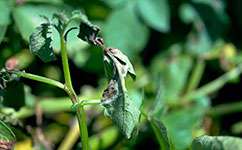Breakthrough in understanding swarming potato-blight spores

Scientists have made a breakthrough in understanding how microbial spores, which caused the infamous Irish potato famine are so successful at infecting plants.
It seems that Phyophthora infestans spores clump together in water, increasing the organism's chance of infection.
Phyophthora infestans is a highly-destructive pathogen, which leads to damages costing three billion dollars each year. The infection is spread through water by the parent releasing tiny spores, called zoospores. But the mechanism by which these spores coordinate an attack on plants has been poorly understood, until now.
In a study, published in the Journal of Royal Society Interface, scientists show for the first time that the zoospores use two mechanisms to bring together enough spores to threaten plants, and they happen over two different timescales.
'If one zoospore lands on a potato leaf it probably won't kill that plant, but the zoospores have developed a swarming behaviour,' explains Dr Fordyce Davidson of the University of Dundee, a researcher on the project. 'It attracts other zoospores and when there's a large mob the infection pressure is enough that the pathogen can get into the plant and kill it.'
This swarming behaviour had previously puzzled researchers, who were unsure how these tiny cells with no brains, eyes or ears were able to signal each other to come together.
Davidson was hopeful that if they could understand the mechanisms, then researchers would have a target for creating treatments to prevent the spread of this disease.
The team placed millions of zoospores into a petri dish and watched to see the patterns they form appear. The patterns the clumping spores made reminded the team of mathematical models they'd seen before that were formed by chemical-sensing patterns.
'We were completely wrong,' says Davidson. 'When we made computer chemical-sensing modelswe couldn't get the right number of spots to form in the dish on the right time scales. We could get the pattern right, but the computer said it would take days, or we could get the timing right, but not the pattern. We thought we'd got it wrong until we realised perhaps it's the opposite way round - these early patterns were being formed by bio-convection.'
These two mechanisms – bio-convection and chemical sensing - had previously been put forward as suggestions for mechanisms behind the aggregating spores, but these previous studies argued that it was one or the other mechanism.
This new research shows that the two mechanisms are both important to the aggregation process, but each performs different roles and works on a different timescale to the other.
'Bio -convection is a sort of swimming pattern the zoospores show. If you take a little cell, which looks like a coffee bean with a fatter bottom then they'll swim upwards because of gravity. It's a very rapid process that works on the order of minutes. It sets up convective plumes, which are structures in the liquid pushing the cells to the top where they can group together,' he explains.
The second mechanism was a form of chemical sensing. Similar to animals being attracted to pheromones, the zoospores are able to send chemical signals to draw in other zoospores.
'The chemical-sensing mechanism happens on the order of days. If you have lots of these plumes in a water drop formed by bio-convection, then the chemical sensing draws these plumes together until you get one super plume, to really drive in the infection,' Davidson says.
A better understanding of the infection's mechanisms could help advance the invention of preventative treatments for potato blight and other similar diseases, and potentially save billions of pounds.
More information: Andrew I. M. Savory, Laura J. Grenville-Briggs, Stephan Wawra, Pieter van West, and Fordyce A. Davidson (2014) "Auto-aggregation in zoospores of Phytophthora infestans: the cooperative roles of bioconvection and chemotaxis" J. R. Soc. Interface DOI: 10.1098/rsif.2014.0017 1742-5662
Provided by PlanetEarth Online
This story is republished courtesy of Planet Earth online, a free, companion website to the award-winning magazine Planet Earth published and funded by the Natural Environment Research Council (NERC).

















